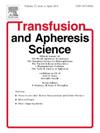Effect of storage temperature and time on growth factor concentration in single-harvest platelet-rich plasma
IF 1.2
4区 医学
Q4 HEMATOLOGY
引用次数: 0
Abstract
Introduction
Based on its therapeutic potential, the Platelet-rich plasma (PRP) therapy doubled in interest. Storage of this blood product in appropriate conditions allows for many interventions and increased clinical use. This research was intended to determine how the change in the storage temperature and time affects the concentrations of the essential growth factors of the PRP, which determines its biological activity.
Methods
PRP was prepared from 10 healthy donors and stored at room temperature (RT; 22°C), 4°C, and −65°C. Aliquots were analyzed at baseline (0 days), 1, 3, and 6 days post-preparation. Growth factors platelet-derived growth factor-AA (PDGF-AA), transforming growth factor-β (TGF-β), vascular endothelial growth factor (VEGF), and fibroblast growth factor-basic (b-FGF) were quantified after activation using Triton-X (PDGF-AA, VEGF, b-FGF) or sonication (TGF-β1), with sandwich immunoassays.
Results
PDGF-AA concentrations consistently declined over time across all storage conditions. In contrast, TGF-β1 levels progressively increased, reaching peak concentrations by day 6. VEGF exhibited a reduction in samples stored at RT and −65 °C, while b-FGF concentrations dropped sharply after 24 h in these same groups. Refrigeration (4 °C) showed intermediate effects on growth factor stability compared to other temperatures.
Conclusion
Growth factor concentrations in PRP varied significantly depending on the activation technique, with no difference in activators for the same growth factor. These findings underscore the importance of optimizing storage protocols to preserve PRP’s bioactive properties. For clinical efficacy, PRP should be activated and stored under conditions that maintain growth factor integrity, ensuring maximal therapeutic benefit.
储存温度和时间对单次收获富血小板血浆中生长因子浓度的影响
基于其治疗潜力,富血小板血浆(PRP)治疗的兴趣翻了一番。在适当的条件下储存这种血液制品可以进行许多干预并增加临床使用。本研究旨在确定储存温度和时间的变化对PRP必需生长因子浓度的影响,从而决定其生物活性。方法10例健康供体制备sprp,室温保存(RT;22°C), 4°C和- 65°C。在准备后的基线(0天)、1天、3天和6天对等分进行分析。使用Triton-X (PDGF-AA、VEGF、b-FGF)或超声(TGF-β1)激活后,用夹心免疫法定量测定生长因子血小板衍生生长因子- aa (PDGF-AA)、转化生长因子-β (TGF-β)、血管内皮生长因子(VEGF)和成纤维细胞生长因子-碱性(b-FGF)。结果spdgf - aa浓度在所有储存条件下均随时间下降。TGF-β1水平逐渐升高,在第6天达到峰值。在RT和- 65°C保存的样品中,VEGF表现出减少,而在相同组中,b-FGF浓度在24 h后急剧下降。与其他温度相比,冷藏(4°C)对生长因子的稳定性有中等影响。结论不同激活方式的PRP中生长因子浓度差异显著,同一种生长因子在不同激活方式下无显著差异。这些发现强调了优化储存方案以保持PRP生物活性特性的重要性。为了临床疗效,PRP应在保持生长因子完整性的条件下激活和储存,以确保最大的治疗效果。
本文章由计算机程序翻译,如有差异,请以英文原文为准。
求助全文
约1分钟内获得全文
求助全文
来源期刊
CiteScore
3.60
自引率
5.30%
发文量
181
审稿时长
42 days
期刊介绍:
Transfusion and Apheresis Science brings comprehensive and up-to-date information to physicians and health care professionals involved in the rapidly changing fields of transfusion medicine, hemostasis and apheresis. The journal presents original articles relating to scientific and clinical studies in the areas of immunohematology, transfusion practice, bleeding and thrombotic disorders and both therapeutic and donor apheresis including hematopoietic stem cells. Topics covered include the collection and processing of blood, compatibility testing and guidelines for the use of blood products, as well as screening for and transmission of blood-borne diseases. All areas of apheresis - therapeutic and collection - are also addressed. We would like to specifically encourage allied health professionals in this area to submit manuscripts that relate to improved patient and donor care, technical aspects and educational issues.
Transfusion and Apheresis Science features a "Theme" section which includes, in each issue, a group of papers designed to review a specific topic of current importance in transfusion and hemostasis for the discussion of topical issues specific to apheresis and focuses on the operators'' viewpoint. Another section is "What''s Happening" which provides informal reporting of activities in the field. In addition, brief case reports and Letters to the Editor, as well as reviews of meetings and events of general interest, and a listing of recent patents make the journal a complete source of information for practitioners of transfusion, hemostasis and apheresis science. Immediate dissemination of important information is ensured by the commitment of Transfusion and Apheresis Science to rapid publication of both symposia and submitted papers.

 求助内容:
求助内容: 应助结果提醒方式:
应助结果提醒方式:


